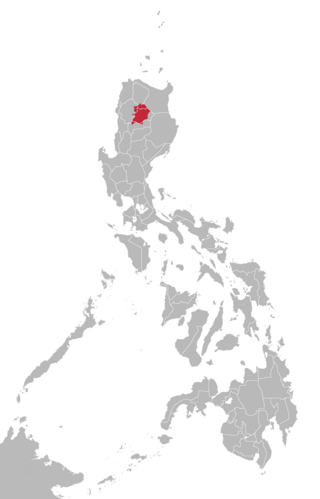Kalinga language
Appearance
| Kalinga | |
|---|---|
| Native to | Philippines |
| Region | most parts of Kalinga, northern parts of Mountain Province, eastern parts of Abra and southern parts of Apayao, Luzon |
Native speakers | (110,000 cited 1998–2008)[1] No estimate for Mabaka Valley |
| Language codes | |
| ISO 639-3 | Variously:bjx – Banao Itnegtis – Masadiit Itnegity – Moyadan Itnegkyb – Butbut Kalingakmk – Limos Kalingakml – Tanudan Kalingaknb – Lubuagan Kalingakkg – Mabaka Valley Kalingakmd – Madukayang Kalingaksc – Southern Kalinga (Bangad) |
| Glottolog | kali1311 |
 Area where the Kalinga dialect continuum is spoken according to Ethnologue | |
[2]Kalinga is a dialect continuum of Kalinga Province in the Philippines, spoken by the Igorot people, alongside Ilocano. The Banao Itneg variety is not one of the neighboring Itneg languages.
Dialects
Ronald Himes (1997)[3] divides Kalinga into 3 dialects.
- Masadiit (in Abra)
- Northern Kalinga
- South-Central Kalinga
Ethnologue reports the following locations for each of the 8 Kalinga languages. Banao Itneg is classified by Ethnologue as Kalinga rather than Itneg.
- Butbut Kalinga: spoken in Kalinga Province: Tinglayan and Butbut; Buscalan, Bugnay, Loccong, and Ngibat; Tabuk City, Lucnang, Pakak, Kataw, and Dinongsay. Also in Rizal Province: Annunang, Malapiat, Andarayan, and Bua. 15,000 speakers.
- Limos Kalinga (Limos-Liwan Kalinga, Northern Kalinga): spoken in Kalinga Province (Tabuk City, north to border) and Conner municipality, Apayao Province. 12,700 speakers.
- Lubuagan Kalinga: spoken in Kalinga Province (Lubuagan and Tabuk City). 30,000 speakers. Dialects are Guinaang, Balbalasang, Ableg-Salegseg, and Balatok-Kalinga (Balatok-Itneg).
- Mabaka Valley Kalinga (Kal-Uwan, Mabaka, Mabaka Itneg): spoken in Conner municipality, Apayao Province, as well as western Abra Province and northern Kalinga Province.
- Majukayang Kalinga (Madukayang): spoken in Tabuk City, Kalinga Province and in Paracelis municipality, Mountain Province. 1,500 speakers as of 1990.
- Southern Kalinga: spoken in Kalinga Province (Lubuagan municipality; some also in Tabuk City) and Mountain Province (13 villages of Sadanga and Sagada municipalities). 11,000 speakers. Dialects are Mallango, Sumadel, Bangad, and Tinglayan.
- Tanudan Kalinga (Lower Tanudan, Lower Tanudan Kalinga, Mangali Kalinga): spoken at the southern end of the Tanudan valley in southern Kalinga Province. 11,200 speakers as of 1998. Dialects are Minangali (Mangali), Tinaloctoc (Taluctoc), Pinangol (Pangul), Dacalan, and Lubo.
- Banao Itneg (Banao, Banaw, Itneg, Timggian, Tinguian): spoken in Kalinga Province (Balbalan and Pasil municipalities) and Abra Province (Daguioman and Malibcong municipalities). 3,500 speakers as of 2003. Dialects are Malibcong Banao, Banao Pikekj, and Gubang Itneg.
Writing System
Lubuagan Kalinga
| a | b | by | k | ch | e | g | h | i | l | m | n | ng | o | p | s | t | u | ɏ | w | y |
References
- ^ Banao Itneg at Ethnologue (18th ed., 2015) (subscription required)
Masadiit Itneg at Ethnologue (18th ed., 2015) (subscription required)
Moyadan Itneg at Ethnologue (18th ed., 2015) (subscription required)
Butbut Kalinga at Ethnologue (18th ed., 2015) (subscription required)
Limos Kalinga at Ethnologue (18th ed., 2015) (subscription required)
Tanudan Kalinga at Ethnologue (18th ed., 2015) (subscription required)
(Additional references under 'Language codes' in the information box) - ^ A Topical Vocabulary in English, Pilipino, Ilocano, and Southern Kalinga. Summer Institute of Linguistics. 1980. pp. iv.
- ^ Himes, Ronald S. (1997). "Reconstructions in Kalinga-Itneg". Oceanic Linguistics. 36 (1): 102–134. doi:10.2307/3623072. JSTOR 3623072.
- ^ Summer Institute of Linguistics 2005.
- Ferreirinho, Naomi (1993). Selected topics in the grammar of Limos Kalinga, the Philippines. Pacific Linguistics Series B-109. Canberra: Dept. of Linguistics, Research School of Pacific Studies, The Australian National University. doi:10.15144/PL-B109. hdl:1885/145804. ISBN 978-0-85883-419-4.
- Brainard, Sherri (1985). Upper Tanudan Kalinga texts. Studies in Philippine Linguistics Supplementary Series: Philippine Texts, 1. Manila: Linguistic Society of the Philippines and Summer Institute of Linguistics.
- Gieser, C. Richard (1987). Guinaang Kalinga texts. Studies in Philippine Linguistics Supplementary Series: Philippine Texts, 4. Manila: Linguistic Society of the Philippines and Summer Institute of Linguistics.
- Olson, Kenneth S.; Machlan, Glenn; Amangao, Nelson (2008). "Minangali (Kalinga) Digital Wordlist: Presentation Form". Language Documentation & Conservation. 2 (1). hdl:10125/1772.
